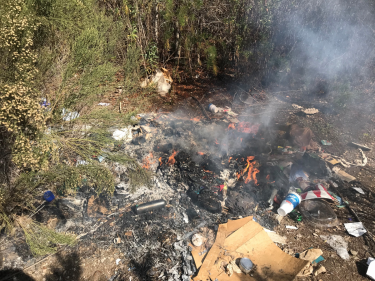

By Karen Pearlman
Photo via San Diego County Sheriff: Homeless encampment fire in Santee, February 2025
March 14, 2025 (San Diego’s East County) -- With an estimated one out of every five fires in San Diego County started in encampments where homeless individuals congregate, San Diego County Supervisor Joel Anderson has said enough is enough.
“Nobody has a right to burn my constituents’ homes down, whether they intend to or not,” Anderson said, two days after the Board of Supervisors voted unanimously to update the county’s Unsafe Camping Ordinance. It would apply to property that the county owns or leases and specified areas such as parks, open space and certain public works facilities.
At their meeting on Tuesday, March 11, the supervisors voted 4-0 to empower appropriate authorities “to ensure public safety and do more than just cite repeat offenders,” Anderson said. A final draft ordinance is expected to be presented by county staff to the board in about two months, when a final vote will take place.

East County News Service
Last week’s storms brought 6-10 inches of snow to our mountains with up to 1.5 inches in urban portions of our county. Now, multiple new storms are moving into the area, with rain now falling across the region and multiple atmospheric rivers soon to drench our region, with the heaviest rains Thursday, the National Weather Service predicts. A flood watch has been issued now through Thursday afternoon for San Diego’s inland and coastal areas, including cities such as La Mesa, Santee, Poway, and Escondido as well as San Diego. Excessive runoff may result in flooding of rivers, streams, and other low-lying and flood-prone locations.
Wednesday night through Thursday afternoon could bring rainfall rates of .5 to 0.75 inches per hour, with up to an inch per hour possible in lower mountain areas, along with thunderstorms. Two to three inches of snow are forecast at higher elevations locally. A winter storm warning will remain in effect from Wednesday afternoon through Friday morning.
Source: Cal Fire
March 2, 2025 (San Diego) – Cal Fire law enforcement investigators have arrested Ruben Vasquez on multiple felony arson charges following an extensive investigation into two wildland fires that ignited on January 21. The fires, known as the Pala Fire and the Lilac Fire, started 25 minutes apart near Interstate 15 and State Route 76 in the Pala Mesa and Bonsall areas.
By Mike Allen
Photo: Santee Fire Department responding in 2023
March 1, 2025 (Santee) -- The chaos and disruption happening daily at the federal government isn’t permeating to the local level in Santee, where the City Council took several significant actions this week, including funding the remaining balance on a $2 million temporary fire station, adopting a new specific plan for its Town Center area, and hearing that its finances are in sterling shape.
East County News Service
February 27, 2025 (Washington D.C.) -- U.S. Senator Alex Padilla (D-Calif.) joined 14 other Democratic Senators in urging senior Trump Administration officials to reverse the hiring and onboarding freeze of federal seasonal firefighters that they say threatens the safety of communities in California and across the nation. The Trump Administration’s January 20 hiring freeze of federal civilian employees inexplicably did not exempt federal seasonal firefighters, despite exempting other critical public safety personnel.
